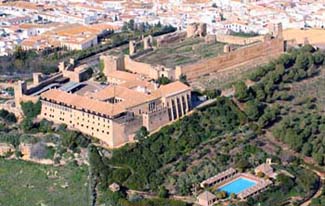
Photos courtesy of Parador de Carmona
Alcázar s/n
41410 Carmona (Sevilla)
Tel: ++34 954 14 10 10
Fax: ++34 954 14 17 12
Official parador website
Reserve with Booking.com
63 rooms
Double rooms: 105–242 euros
Single rooms: 80% of double
room rate
Rates include tax. Breakfast extra.
Free Wi-Fi
Open: all year
Carmona is 30 km east of Sevilla, off the National IVhighway. Buses leave every hour. The parador is well signposted.
On site: seasonal swimming
pool
Nearby: golf; walks around
the historic town of
Carmona; excursions to
Sevilla
The Parador de Carmona sits along the ancient wall of the southeast side of the city of the same name. Its wonderful views look out over miles of plains dotted with small farms. The reconstruction of the main palace took six years to complete.
The inside Moorish courtyard has a fountain in the middle of a garden, Mudéjar brick archways, columns, and blue tile work. Windows are covered with lattice-work screens.
Spacious guest rooms are painted in muted shades of whate and gray, with white Moorish tiles embellishing the walls. Throw rugs cover large-tiled floors and furnishings include big comfy chairs. Many rooms feature four-poster beds and wooden doors that open out onto a balcony.
The dining room is now in the former refectory, a charming room with high vaulted ceilings, wooden beams, and tall windows that look out over the valley.
![]() Great panoramic views over the plain
Great panoramic views over the plain
![]() The town of Carmona is a Spanish National Monument
The town of Carmona is a Spanish National Monument